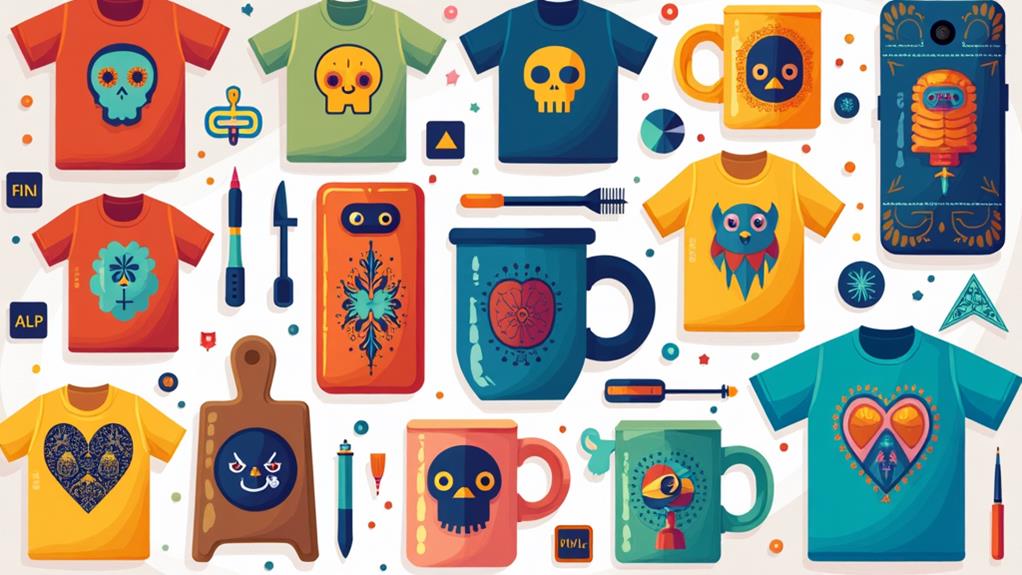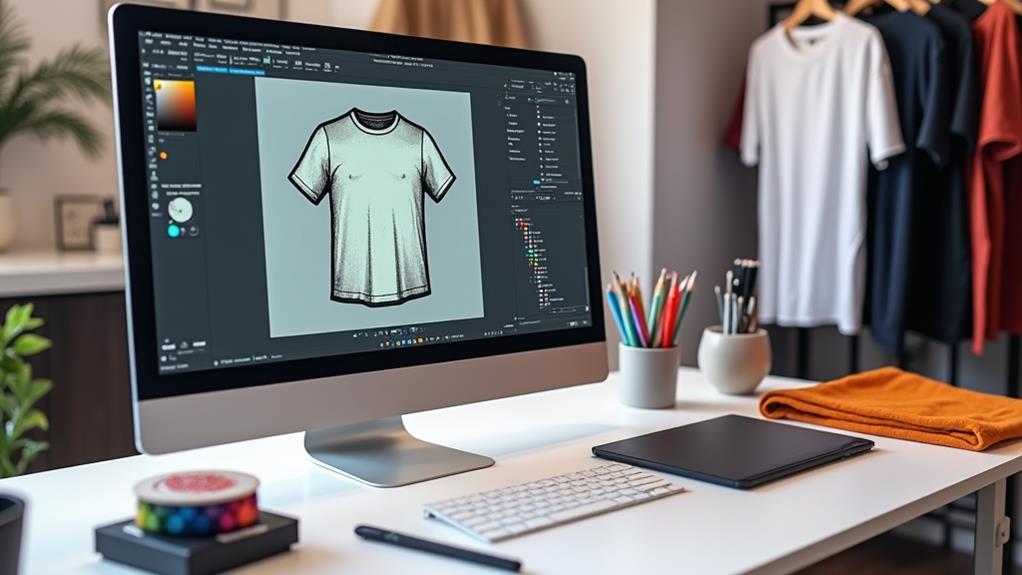
Designing products that sell on print-on-demand platforms involves strategically combining market analysis, niche selection, and impactful design elements. Start by selecting a profitable niche using tools like Google Trends to identify high-demand, low-competition markets. Focus on designs that evoke emotional appeal, leveraging color psychology and trending cultural references. Emphasize simplicity and consistency in your designs to enhance engagement. Additionally, technical preparation, such as ensuring high-resolution quality and appropriate file formats, is essential. By understanding and implementing these elements, you position your products for success in a competitive market, with more insights available to optimize your approach.
Key Takeaways
- Select a Profitable Niche: Use tools like Google Trends to find high-demand, low-competition markets.
- Leverage Emotional Appeal: Utilize color psychology and relatable messages to enhance customer engagement and drive purchasing decisions.
- Ensure Design Simplicity and Consistency: Create minimalist designs with clear typography and cohesive color palettes to boost brand recognition and sales.
- Create Unique Product Variations: Offer seasonal or thematic variations to attract new customers and encourage repeat purchases.
- Prepare Technical Design Files: Maintain high print resolution (300 DPI) and use appropriate formats (.ai, .psd, .png) for quality prints.
Understanding Print on Demand
Understanding Print on Demand (POD) is vital for modern entrepreneurs looking to enter a low-risk, high-potential market. POD Basics involve creating custom products only after an order is placed, effectively minimizing inventory costs and enabling sellers to test new designs without significant upfront investment.
The streamlined Production Process, managed by POD suppliers, guarantees that product creation aligns directly with customer demand, enhancing efficiency. Securing commercial licenses for third-party designs is essential for credibility and avoiding legal complications.
Shipping Logistics are also handled by POD suppliers, allowing sellers to focus on key business aspects like Customer Engagement and Marketing Techniques. By leveraging Seller Platforms, entrepreneurs can showcase their products to a global audience with minimal effort.
Strategic Pricing Strategies are vital to maintaining competitive advantage while maximizing profit margins. Quality Control is paramount, given the custom nature of POD products. Using advanced Design Tools, sellers can guarantee their products meet high standards, reflecting positively on their brand.
Effective Inventory Management is simplified in the POD model, as there's no need for large storage facilities or extensive stockpiling.
Ultimately, understanding these elements enables entrepreneurs to capitalize on the rapidly growing POD market, projected to reach $48.4 billion by 2032, by delivering unique, high-quality products that resonate with customers.
Selecting a Profitable Niche
Selecting a profitable niche is essential for success in print-on-demand, necessitating a keen analysis of market trends and audience demographics. Tools like Google Trends can offer valuable insights into emerging markets with high demand and manageable competition, ensuring ideal sales potential.
Balancing niche specificity with broad appeal is vital, as it enables you to target dedicated customer bases without diluting brand identity.
It is also important to conduct thorough market research to understand demand and competition within your chosen niche. This helps in identifying potential gaps and opportunities, consequently maximizing conversion potential.
Market Trends Analysis
Steering through the dynamic landscape of the print-on-demand industry requires a keen eye for market trends, as these insights can be pivotal in selecting a profitable niche. Analyzing market trends through tools like Google Trends is essential for effective trend forecasting, revealing categories with consistent consumer interest such as fitness, pets, and hobbies.
Over 60% of successful print-on-demand businesses leverage specific sub-niches—like particular dog breeds or unique hobbies—enhancing relevance and customer engagement by aligning closely with consumer behavior.
The global print-on-demand market's projected growth to $48.4 billion by 2032 underscores the ample opportunities for entrepreneurs to capitalize on emerging trends. Seasonal products also present significant potential, with certain niches experiencing sales spikes during specific times of the year, such as holiday-themed designs.
Engaging with target audiences on social media platforms can be particularly insightful, providing real-time data on trending interests and allowing designers to adapt their offerings accordingly.
Audience Demographic Insights
Diving into the intricacies of audience demographic insights is essential for carving out a profitable niche in the print-on-demand industry. Understanding your target audience's demographics, such as age, gender, interests, and buying behaviors, can greatly enhance your ability to create designs that resonate and drive sales.
Here are four actionable steps to harness these insights effectively:
- Market Research: Investigate trending niches like eco-friendly products or fitness gear. The global eco-friendly market is projected to reach $150 billion by 2027, indicating a lucrative opportunity.
- Customer Engagement: Utilize surveys and social media polls to engage with potential customers. These tools provide insights into their preferences and pain points, allowing you to tailor your designs to meet their needs.
- Competitive Analysis: Examine competitors within your chosen niche to identify market gaps. Remarkably, 60% of consumers prefer brands that offer personalized experiences, highlighting the potential for unique, customer-centered designs.
- Trend Tracking: Use tools like Google Trends to identify popular search terms and emerging interests. This data can guide you in creating products that cater to current market demands and seasonal trends.
Simplicity in Design
In the domain of print on demand, simplicity in design serves as a powerful catalyst for consumer engagement and sales success. Minimalist trends have shown that consumers favor designs that are easy to process and remember. Research underscores that designs with fewer elements tend to boost conversion rates by reducing visual clutter, which often confuses potential buyers.
The strategic use of whitespace is another crucial aspect of simplicity, as it enhances visual appeal and allows products to stand out in competitive marketplaces like Etsy and Redbubble. Engaging with followers on social media by sharing behind-the-scenes content can further amplify the impact of simple designs, making your brand more relatable and trustworthy.
Effective typography plays an essential role in simple designs by guaranteeing clarity and readability, which are important for conveying messages quickly and effectively. This approach not only fosters emotional connections with consumers but also aligns with the fact that 95% of purchasing decisions are emotion-driven.
Simple, catchy designs are also highly adaptable, making them suitable across a variety of products and niches. This flexibility guarantees that designs resonate with a broader audience, increasing the potential for higher sales.
Emotional Appeal in Designs
Emotional appeal in design is essential, as it triggers positive emotions that drive 95% of purchasing decisions.
Utilizing color psychology to evoke specific feelings and crafting relatable messages can greatly enhance customer engagement and satisfaction. By strategically employing warm colors to generate excitement and cool tones to instill calmness, along with messages that resonate with customers' identities and aspirations, designers can create print-on-demand products that not only appeal to but also deeply connect with their target audience.
Additionally, trend analysis aids in creating appealing designs that stay relevant in a fast-changing market, thereby fostering a deep resonance with the audience.
Consistent design quality is also vital as it builds a reputable brand identity, ensuring long-term success.
Triggering Positive Emotions
Often, the power of design lies in its ability to evoke positive emotions, a critical factor as 95% of purchasing decisions are driven by how consumers feel.
To create a compelling emotional appeal, integrating humor and nostalgia elements can be highly effective. Humor integration in designs can make products more relatable and engaging, leading to higher conversion rates. Meanwhile, nostalgia elements tap into the customer's positive memories, enhancing emotional resonance and making products more appealing.
Here are four key strategies to trigger positive emotions in your designs:
- Humor Integration: Use witty slogans or light-hearted illustrations to bring a smile to your customers' faces. This can increase the likelihood of them sharing your product, thereby boosting its visibility.
- Nostalgia Elements: Incorporate retro designs or references to past trends that evoke fond memories. This connection can create a powerful emotional bond, making your products more memorable.
- Personal Milestones: Design products for specific life events like birthdays or anniversaries. This adds personal relevance, making the purchase feel more meaningful.
- Relatable Themes: Create designs that resonate with your audience's everyday experiences and values. This fosters a sense of connection and loyalty to your brand.
Utilizing Color Psychology
Harnessing the power of color psychology can greatly enhance the emotional appeal of your product designs, directly influencing consumer behavior and purchasing decisions. Studies indicate that up to 90% of snap judgments about products are based on color alone. This underscores the importance of selecting the right color combinations to evoke desired emotions and reactions from your target audience.
Warm colors such as red and orange are known to evoke feelings of excitement and urgency, making them ideal for promotional items like limited-time offers or flash sales. In contrast, cool colors like blue and green create a sense of calmness and trust, which can be incredibly effective for brands aiming to cultivate long-term customer loyalty.
Strategic use of color combinations not only enhances emotional branding but also considerably boosts brand recognition—by up to 80%. For instance, purple, often associated with creativity, appeals particularly to younger demographics, while more muted tones can attract older consumers.
Crafting Relatable Messages
In the competitive landscape of print on demand, crafting relatable messages within your designs is paramount to capturing consumer interest and driving sales. Emotional appeal is a powerful tool, with 95% of purchasing decisions influenced by emotions. To leverage this, focus on designs that resonate deeply with your target audience by integrating elements such as cultural references and seasonal themes.
To create emotionally engaging designs, consider the following strategies:
- Target Specific Demographics: Tailor your messages to resonate with particular groups. Use humor or nostalgia to evoke positive emotions, creating a connection that encourages purchases.
- Incorporate Trending Phrases or Memes: Leverage popular cultural references that are widely recognized and shared on social media. This can enhance relatability and virality, driving more traffic to your products.
- Simplify Your Messaging: Guarantee your designs are clear and straightforward. Overly complex designs can confuse potential customers and reduce conversion rates.
- Test Various Emotional Triggers: Experiment with different emotional appeals such as empathy or humor to see which resonates most with your audience. This can lead to higher engagement and better sales performance.
Adding Unique Variations

Incorporating unique variations into your print-on-demand products is critical for distinguishing your offerings in a competitive marketplace. Leveraging design inspiration from trending elements and infusing your unique style can effectively capture customer engagement and set your products apart.
Analyzing successful designs within your niche allows you to adapt them by modifying color schemes, typography, or layouts, guaranteeing a fresh appeal to your target audience. Using market research tools can help you find oversaturated areas and untapped growth opportunities, which is essential for staying competitive.
Additionally, defining your target audience and understanding their specific needs and preferences will help tailor your designs more effectively. Customer feedback and social media insights are invaluable tools for identifying market gaps.
By understanding unmet needs, you can introduce unique variations tailored to customer desires, enhancing both interest and sales potential. Experimentation across different product types, such as apparel, home decor, and accessories, further maximizes audience reach and engagement. This approach guarantees your designs resonate with diverse customer segments.
Furthermore, regularly updating your offerings with seasonal or thematic variations, such as holiday-themed graphics, keeps your product line relevant. This strategy not only attracts new customers but also encourages repeat purchases from existing ones, sustaining long-term engagement.
Consistency in Your Style
Establishing consistency in your design style is paramount to fostering brand recognition and standing out in the crowded print-on-demand market. Consistent branding can increase revenue by up to 23%, making it an essential strategy for success.
Adhering to specific design guidelines guarantees that your products present a unified visual hierarchy, enhancing brand storytelling and customer engagement. Utilizing tools like WordPress or Shopify can assist in maintaining a cohesive aesthetic across your online store.
To achieve aesthetic consistency, consider the following:
- Color Palette: Maintain a cohesive color palette across your designs. Color consistency influences consumer perception and emotional response, reinforcing brand identity.
- Typography: Utilize a uniform typography style to strengthen brand voice and readability. This uniformity enhances user experience and connection with your products.
- Design Feedback: Regularly analyze customer feedback and sales data. This practice helps refine your design consistency, aligning with consumer preferences and guaranteeing design evolution.
- Market Positioning: Conduct competitive analysis to understand market positioning. A recognizable design style, whether minimalist, vintage, or modern, can lead to increased customer loyalty and differentiation in the market.
Knowing Your Target Audience

Understanding your target audience is pivotal for creating successful print-on-demand products. By analyzing demographic data such as age, gender, and location, alongside psychographic insights like interests and values, you can tailor designs that resonate deeply with potential customers.
Combining these insights with competitive research and direct engagement guarantees your offerings are both relevant and compelling, ultimately driving higher sales and customer loyalty.
Additionally, integrating metrics analysis from platforms can further refine your product strategies. Using reliable tracking systems helps monitor performance and optimize designs for better engagement.
Demographic Data Analysis
To effectively tailor your designs for print on demand, delving into demographic data analysis is crucial. This involves leveraging demographic segmentation and consumer profiling to understand and cater to the specific needs of your target market.
By collecting data such as age, gender, location, and interests, you can create designs that resonate deeply with your audience, thereby enhancing engagement and increasing sales potential.
Here are four key steps to utilize demographic data effectively:
- Data Collection: Gather thorough demographic data using tools like Google Trends and social media analytics. Focus on identifying trends in age, gender, location, and interests to inform your design strategy.
- Competitor Analysis: Study the demographics of your competitors' audiences. This can help identify market gaps and opportunities, allowing you to position your products uniquely within the niche.
- Regular Updates: Demographics can shift over time. Regularly updating and revisiting your demographic data guarantees that your designs remain relevant and appealing to your audience.
- Targeted Design: Use the insights gained from demographic segmentation and consumer profiling to create targeted designs. This approach guarantees that your products speak directly to the preferences and interests of your target market, driving higher engagement and sales.
Psychographic Insights Utilization
Effectively harnessing psychographic insights can profoundly enhance your print on demand design strategy. Understanding consumers' lifestyles, interests, values, and attitudes is critical in creating designs that achieve lifestyle alignment and values integration.
By focusing on emotional triggers, which influence 95% of purchasing decisions, you can develop products that forge a strong audience connection and resonate deeply with your target market.
Engaging in community engagement through surveys and direct interaction provides invaluable customer feedback, helping to refine niche markets and tailor your offerings more precisely.
Analyzing competitors' successful products through competitor analysis can shed light on the psychographic traits of their customer base, allowing you to adjust your designs for better market fit and enhanced design resonance.
Utilizing tools like Google Trends and social media analytics for trend identification keeps you abreast of current consumer interests, ensuring your designs reflect the latest preferences.
This proactive approach not only aligns your products with existing demand but also positions them favorably within emerging trends.
Ultimately, integrating these psychographic insights into your design process fosters a deeper connection with your audience, driving both customer satisfaction and sales performance.
Gathering and Brainstorming Ideas
Maneuvering the initial stages of designing products for print on demand necessitates a strategic approach to gathering and brainstorming ideas. This phase is vital for identifying your niche and guaranteeing your designs align with market trends and consumer preferences. Here are key steps to streamline this process:
1. Research Current Trends: Utilize tools like Google Trends and social media platforms to gather design inspiration. Understanding what themes and styles are currently in demand will help in creating products that resonate with your target audience.
Additionally, exploring eco-friendly handmade products can provide insights into sustainable trends that are gaining traction.
2. Conduct Competitor Analysis: Explore successful print-on-demand shops on platforms such as Etsy and Redbubble. Analyzing their effective design elements and unique offerings can provide valuable insights and highlight opportunities for differentiation.
3. Engage in Creative Collaboration: Employ brainstorming techniques like mind mapping or collaborative sessions to generate a diverse range of ideas. This approach guarantees that your designs reflect your niche and brand values while fostering innovation.
Integrating elements from popular niches, such as vintage-inspired crafts, can help capture a broader audience.
4. Seek Feedback: Gather input from potential customers or target audience groups on initial design concepts. This feedback is invaluable for refining ideas and guaranteeing they are market-relevant and appealing.
Creating a mood board can further help in visually compiling inspiring designs, color palettes, and typography, keeping the brainstorming process focused and aligned with your brand aesthetic.
Technical Design Preparation

Having established a strong foundation through thorough idea gathering and brainstorming, the next step involves meticulous technical design preparation to guarantee your concepts translate seamlessly into high-quality print-on-demand products.
Confirming your design files match the specific print area of the product is essential, as incorrect dimensions can lead to misprints or cropped designs, which can negatively impact customer satisfaction and sales.
Maintaining high print resolution standards is critical; aim for a resolution of 300 DPI. This guarantees that your designs remain sharp and detailed, avoiding pixelation that can diminish the product's appeal.
Additionally, using appropriate design file formats such as .ai, .psd, or .png is necessary for maximum compatibility and quality during the print production process. Optimizing your content quality can lead to a significant increase in website visits, as engaging content can result in 7.8 times more site traffic.
Understanding the color model importance is another key aspect. Utilize the CMYK color model for accurate color representation, as RGB often fails to translate correctly when printed, leading to inconsistent color outcomes.
Finally, consider the bleed settings necessity in your designs. Including extra space around the artwork prevents critical elements from being cut off, guaranteeing a professional and polished final product.
These technical preparations are fundamental to creating successful print-on-demand products that captivate and retain customers.
Choosing Design Tools
Selecting the right design tools is pivotal for creating successful print-on-demand products. The choice of design software greatly impacts your user experience, design versatility, and overall efficiency. A robust content strategy aligns with your design goals to guarantee that the tools you choose resonate with your needs.
Here are the top tools to examine:
- Adobe Illustrator and Photoshop: These industry-standard tools offer advanced features essential for producing high-quality design files at 300 DPI. Their extensive feature set justifies the cost, making them ideal for professionals focused on detail and precision. A thorough feature evaluation will reveal their unmatched capabilities in vector graphics and photo editing.
- Canva: Known for its user-friendly interface, Canva is perfect for beginners. It provides a variety of templates and elements, making complex designs accessible without extensive graphic design skills. The platform's collaboration options and accessibility factors enhance team projects and streamline workflows.
- Printify and Printful: These platforms include built-in design tools, allowing users to customize products directly, thereby simplifying the design-to-print process. This integration offers a seamless user experience and is advantageous for those seeking a streamlined approach.
- Freepik and Vecteezy: These resources provide both free and paid design assets, such as illustrations and templates. They are cost-effective solutions for enhancing your designs, saving valuable time and expenses.
Evaluating these tools based on your specific needs will guarantee a well-informed choice, optimizing your design process for print-on-demand success.
In-House vs. Hiring Designers

Deciding between in-house design and hiring professional designers is a critical choice that can greatly impact your print-on-demand business's success.
In-house design offers substantial creative control and brand alignment, making sure that the designs resonate with your brand values and audience preferences. The ability to quickly iterate based on real-time customer feedback adds a layer of design flexibility, allowing rapid adjustments in response to market trends.
Additionally, combining in-house design with Fitness Mentors COPT strategies can offer valuable insights into online business skills, improving the overall execution of your design projects.
However, hiring professional designers can greatly enhance the quality of your product offerings. High-quality outputs and unique creations from skilled designers can boost the appeal of your products, making them more attractive to customers.
Although the cost of hiring a designer ranges from $10 to $50 per design, this investment can yield higher sales and improved marketability.
Balancing the two approaches can lead to the best resource optimization. Combining in-house efforts with external expertise allows you to leverage the strengths of both strategies.
In-house designers can focus on maintaining brand alignment and quick iterations, while professional designers contribute fresh perspectives and advanced skills, enhancing the overall quality assessment of your designs.
This hybrid approach guarantees both cost-effectiveness and a continual skill improvement within your team.
Leveraging Market Insights
Effectively leveraging market insights is essential for creating successful print-on-demand products that resonate with your target audience. By using a strategic approach to gather and analyze data, you can fine-tune your designs to meet the preferences and demands of your customers.
Here are four key strategies for leveraging market insights:
1. Conducting Thorough Market Research: Utilize tools like Google Trends and surveys to identify popular design trends and customer segmentation. This information will help you create products that align with current market demands.
Accurate income reporting, as advised for compliance with HMRC regulations, is also vital for understanding financial performance.
2. Analyzing Competitors: Platforms such as Etsy and Redbubble are goldmines for understanding what works. By examining successful design elements and niches, you can gain insights into what resonates with buyers and where there might be gaps in the market.
3. Engaging with Customer Feedback: Reviews and social media interactions offer invaluable information. Pay attention to feedback to understand what customers love and areas needing improvement, which can guide design enhancements and inspire new product ideas.
4. Joining Niche Communities: Participating in forums and niche groups allows you to uncover specific interests and emerging design trends within your target audience, enabling you to create more tailored and relevant product offerings.
Frequently Asked Questions
What Makes a Good Print on Demand Design?
A good print-on-demand design effectively balances simplicity, emotional appeal, and consistency. By incorporating trending design elements and understanding the target audience's preferences, products become more engaging and recognizable, thereby increasing their marketability and sales potential.
How to Create Artwork for Print on Demand?
To create artwork for print on demand, utilize design tools like Adobe Illustrator and Photoshop. Apply color theory principles with the CMYK model for accurate printing. Confirm designs are high-resolution and align with product-specific dimensions for ideal results.
Can You Really Make Money Selling Print on Demand?
Absolutely, one can make money selling print-on-demand products by focusing on profit margins, identifying a target audience, employing robust marketing strategies, selecting profitable niches, ensuring quality control, staying abreast of design trends, and utilizing customer feedback.
Can I Use Designs From Canva for Print on Demand?
Yes, you can use Canva designs for print on demand, provided you adhere to Canva licensing agreements. Guarantee design originality and commercial use compliance, especially with premium elements, to create marketable, trend-aware products with professional quality.
Conclusion
To succeed in the competitive landscape of print on demand platforms, a thorough approach encompassing niche selection, simplicity, emotional resonance, and unique variation is imperative. Technical design preparation and the judicious choice of design tools further enhance product appeal. Deciding between in-house design capabilities and external hiring can optimize resource allocation. Leveraging market insights guarantees alignment with current trends, ultimately driving sales and guaranteeing market relevance. Effective execution of these strategies is paramount for achieving commercial success.
Leave a Reply